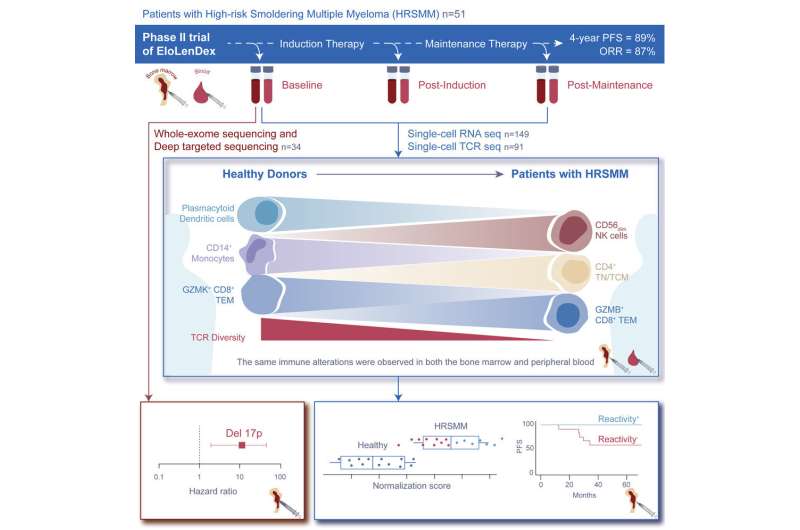voltaren tablet obat untuk


For many patients with a condition that often precedes multiple myeloma, early treatment can slow or delay the progression to myeloma. In a new study, investigators at Dana-Farber Cancer Institute demonstrate that changes in immune system cells can indicate which patients with high-risk “smoldering” myeloma are likely to progress to myeloma and which will benefit the most from treatment.
The findings, posted online today in the journal Cancer Cell, prilosec black box stem from a clinical trial that showed a combination of an immunotherapy drug and standard treatment to be safe and effective in this group of patients. The results point not only the combination’s ability to stave off progression toward myeloma but also to a new set of “biomarkers” that can be used to select patients for treatment and assess how well they’re responding to it.
“Our results show that by taking an ‘immunological profile’ of patients with high-risk smoldering myeloma, we may be able to identify those who stand to be helped by therapy,” says the study’s first author, Romanos Sklavenitis-Pistofidis, MD, of Dana-Farber and the Broad Institute of MIT and Harvard.
“Our data also show that patients’ blood shares many of the same immunological changes that we see in the bone marrow. This raises the possibility of a blood test not only to detect immune dysregulation in patients but to monitor it in response to treatment.”
Smoldering myeloma is a symptomless condition in which patients have large amounts of an abnormal protein, called monoclonal protein, in their blood and high levels of abnormal plasma cells in their bone marrow. About half of patients with the condition develop myeloma within five years of diagnosis, but some never develop the disease. Patients with smoldering myeloma categorized as “high risk” are especially likely to develop myeloma, at which point treatment is necessary.
Multiple myeloma itself is a cancer of white blood cells in the bone marrow called plasma cells, which fight infections and other diseases. It is standard practice not to treat patients with smoldering myeloma until they develop myeloma symptoms. Patients with high-risk smoldering myeloma, however, can be treated prior to the emergence of symptoms, usually as part of a clinical trial. While treatment advances have extended the period in which many patients can live with the disease, it remains incurable.
In recent years, there have been multiple clinical trials of treatments that aim to impede or halt smoldering myeloma from progressing to full-blown myeloma. Two phase III trials have shown that the immune-modulating drug lenalidomide, by itself or in combination with the anti-inflammatory drug dexamethasone, which has great activity against myeloma cells, can significantly extend the period before progression occurs in patients with high-risk smoldering myeloma.
In the new, phase II study, investigators treated 51 such patients with a regimen of lenalidomide, dexamethasone, and elotuzumab, an antibody drug that rouses an immune system attack on myeloma cells. As part of the study, the researchers collected 149 blood and bone marrow samples from the patients and from people without smoldering myeloma, and separated out the immune system cells from each sample.
They then analyzed the RNA within these cells, which enabled them to detect changes in gene expression and in the T cell receptor—a protein on T cells that recognizes proteins from diseased cells. That recognition triggers an immune attack on the disease and allows the immune system to form a memory against it. They used this information to identify the types of immune cells present in each sample, as well as the relative levels of each subtype.
The investigators found that 87% of patients eligible for the study responded to the three-drug combination and 95.6% were alive two years after treatment. Although the trial didn’t include a comparison group of patients who were untreated, the results indicate that the treatment was safe and effective, the study authors say, as the rate of progression to myeloma was lower than expected for patients with high-risk smoldering myeloma.
When the researchers compared the types of immune system cells in patients and in healthy volunteers, they found that patients whose immune cell composition in the bone marrow was least like that of healthy individuals had a significantly longer progression-free survival—the amount of time before their condition began to worsen.
Presumably, this was because the balance of T cells in the marrow had shifted toward cells best equipped to attack myeloma. Researchers also found that patients with a greater abundance of T cells known as granzyme K (GZMK)+ CD8+ effector memory T cells responded best to the three-drug treatment.
Lastly, the investigators found that many of the immune changes that had occurred in patients’ bloodstream resembled those in the bone marrow. This opens the prospect of a simple blood test to detect and monitor immune dysregulation in patients and perhaps, one day, a test to select patients with the highest likelihood of benefiting from treatment.
More information:
Romanos Sklavenitis-Pistofidis et al, Immune biomarkers of response to immunotherapy in patients with high-risk smoldering myeloma, Cancer Cell (2022). DOI: 10.1016/j.ccell.2022.10.017
Journal information:
Cancer Cell
Source: Read Full Article